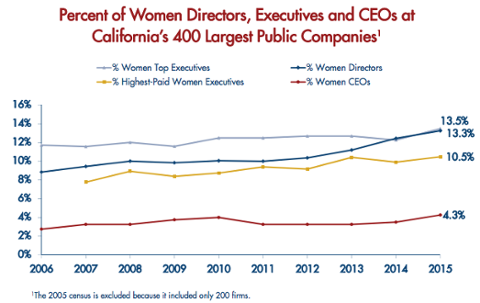
Diversity in tech remains a hot topic, as several companies have not only acknowledged the problem but also pledged to hire more women and minorities. While there’s been slow progress in the industry, there’s still plenty of work to do. Only 9 percent of tech workers are black or Latino, and while women hold 57 percent of all professional occupations, they are
only 25 percent of the tech workforce. It’s no surprise the numbers are even lower in the C-suite, with women holding 20 percent of executive roles and blacks and Latinos holding only 2 percent and 5 percent respectively, according to
a recent report. But the dearth of diversity in leadership hasn’t discouraged ambition. About 62 percent of women in tech desire C-suite or senior management positions in the future, according to
a report by the National Center for Women & Information Technology (NCWIT). So how can minorities and women advance in tech when the numbers are stacked against them? Here are some tips to break through the glass ceiling.
Start Small
Climbing the corporate ladder at Google or Apple might be the end goal, but the best route to executive roles may not be at major tech companies. Everette Taylor, VP of marketing for Skurt, advises ambitious tech workers to dream big but start small. “A lot of minorities have the dream of working for the big tech companies, but at the end the day, if they’re not taking you, start small,” said Taylor, an African-American who founded multiple startups and led marketing projects at Microsoft. “Whether it’s working at a small startup or at a company that may be older. For example, an IBM is going to be way easier to get into than a Google or a Facebook.” Taylor says if you build your reputation at a smaller company, it can open doors to advance your career in the future.
Build a Support Network
Hard work is important, but it’s not the only thing that leads to career advancement. It’s also essential to have mentors and a support network within the company—particularly for women and minorities. “Finding a mentor, whether male or female, is helpful because people who have reached leadership positions can give you great advice on how to navigate the politics in the organization,” said Bonnie Marcus, author of
The Politics of Promotion: How High-Achieving Women Get Ahead and Stay Ahead. Women in tech have struggled in this area, as about 50 percent say they don’t have mentors, according to the NCWIT. Women without mentors are more likely to leave companies due to lack of support. Marcus says you don’t have to be an extrovert to build a support network. It just takes meeting with someone once a week over coffee or lunch to build a relationship and make them aware of your goals. But mentors are more than just cheerleaders. They are advocates who show tough love. “Women who are looking to rise up in leadership must be supported by others who demand that they be their best selves,” said Ellen Petry Leanse, a former Google exec and an early leader at Apple. “They need leaders who, to quote author Kim Scott, are willing to be radically candid with them.”
Be Wary of Building Your Brand
While it’s important for tech workers to stand out, building a personal brand might not be the best way to advance. Executives at big tech companies see it as a distraction for employees, according to Taylor. “I have seen minorities and women get judged way more for having a personal brand,” Taylor said. “I’ve encountered it myself. I’ve been in an executive role and they told me that no man can be bigger than the brand. They told me to continue working there I had to stop with my personal brand.”
Run Your Own Operating Mode
So how can tech workers stand out to decision-makers? It’s about being authentic. “We have to find what our superpower is inside, what our differentiator is, and use that as fuel,” Leanse said. That “superpower” can be a skill set or even a personal characteristic, as long as it’s authentic. Leanse says authenticity stands out because, in today’s world, people are pressured to fit into other people’s definition of them based on their gender, age, race, and education. But being true to self goes a long way. “In technology, there’s native mode, which is the code written to run you, and then there’s emulation mode, which is where you act like another type of machine,” Leanse said. “Emulation mode always crashes. Run in native mode.” When minorities and women are in leadership roles, they help create an easier path for others. Following these tips can help them advance and diversify tech from a place of influence.
 Diversity in tech remains a hot topic, as several companies have not only acknowledged the problem but also pledged to hire more women and minorities. While there’s been slow progress in the industry, there’s still plenty of work to do. Only 9 percent of tech workers are black or Latino, and while women hold 57 percent of all professional occupations, they are only 25 percent of the tech workforce. It’s no surprise the numbers are even lower in the C-suite, with women holding 20 percent of executive roles and blacks and Latinos holding only 2 percent and 5 percent respectively, according to a recent report. But the dearth of diversity in leadership hasn’t discouraged ambition. About 62 percent of women in tech desire C-suite or senior management positions in the future, according to a report by the National Center for Women & Information Technology (NCWIT). So how can minorities and women advance in tech when the numbers are stacked against them? Here are some tips to break through the glass ceiling.
Diversity in tech remains a hot topic, as several companies have not only acknowledged the problem but also pledged to hire more women and minorities. While there’s been slow progress in the industry, there’s still plenty of work to do. Only 9 percent of tech workers are black or Latino, and while women hold 57 percent of all professional occupations, they are only 25 percent of the tech workforce. It’s no surprise the numbers are even lower in the C-suite, with women holding 20 percent of executive roles and blacks and Latinos holding only 2 percent and 5 percent respectively, according to a recent report. But the dearth of diversity in leadership hasn’t discouraged ambition. About 62 percent of women in tech desire C-suite or senior management positions in the future, according to a report by the National Center for Women & Information Technology (NCWIT). So how can minorities and women advance in tech when the numbers are stacked against them? Here are some tips to break through the glass ceiling.
 Diversity in tech remains a hot topic, as several companies have not only acknowledged the problem but also pledged to hire more women and minorities. While there’s been slow progress in the industry, there’s still plenty of work to do. Only 9 percent of tech workers are black or Latino, and while women hold 57 percent of all professional occupations, they are only 25 percent of the tech workforce. It’s no surprise the numbers are even lower in the C-suite, with women holding 20 percent of executive roles and blacks and Latinos holding only 2 percent and 5 percent respectively, according to a recent report. But the dearth of diversity in leadership hasn’t discouraged ambition. About 62 percent of women in tech desire C-suite or senior management positions in the future, according to a report by the National Center for Women & Information Technology (NCWIT). So how can minorities and women advance in tech when the numbers are stacked against them? Here are some tips to break through the glass ceiling.
Diversity in tech remains a hot topic, as several companies have not only acknowledged the problem but also pledged to hire more women and minorities. While there’s been slow progress in the industry, there’s still plenty of work to do. Only 9 percent of tech workers are black or Latino, and while women hold 57 percent of all professional occupations, they are only 25 percent of the tech workforce. It’s no surprise the numbers are even lower in the C-suite, with women holding 20 percent of executive roles and blacks and Latinos holding only 2 percent and 5 percent respectively, according to a recent report. But the dearth of diversity in leadership hasn’t discouraged ambition. About 62 percent of women in tech desire C-suite or senior management positions in the future, according to a report by the National Center for Women & Information Technology (NCWIT). So how can minorities and women advance in tech when the numbers are stacked against them? Here are some tips to break through the glass ceiling.



